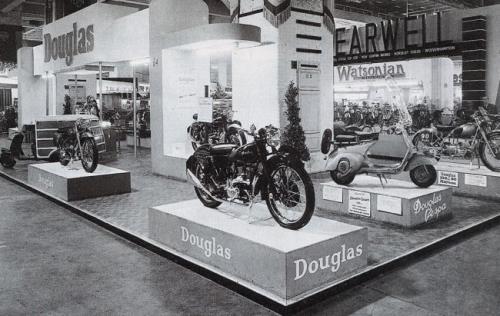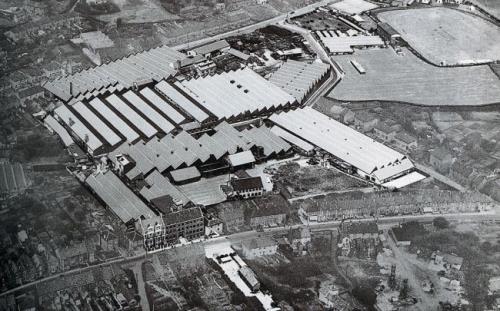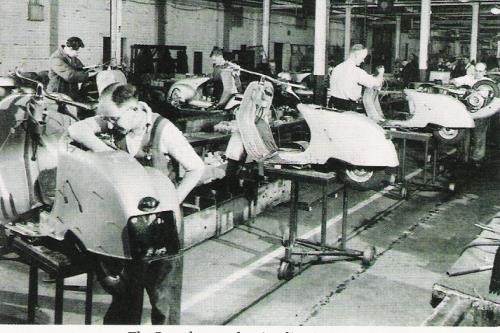The Douglas company of Kingswood, Bristol, commenced motorcycle production in 1907. By 1948 it was effectively bankrupt, actually going into receivership that year. When on holiday in Italy the same year the Managing Director, Claude McCormack, caught sight of a Vespa and soon made arrangements with Piaggio to build it under licence in Bristol.
A Piaggio built machine was on the Douglas stand at the Motorcycle Show at Earls Court in 1949, but production did not actually start until April 1951. The early Vespas were almost entirely built in Britain. The Douglas Foundry churned out items such as engine bearers, clutch covers and cylinder heads, whilst from the machinery shop came gear clusters, brake drums and much else besides. Most of the pressings were made by Pressed Steel in Birmingham. After the introduction of the 152L2 model, more parts were sourced from Piaggio. The Douglas factory was always, however, more than a mere assembly plant.
There was a proper (if rather small) assembly line and a paint shop with infrared drying equipment. Amongst the "bought in" components was quite a lot of "local content", items such as saddles, carbs, tyres and some electrical components being British made.
Vespa production ceased in 1965 after 126,230 units had been completed. Douglas continued to be the British importer of Vespas (models such as the GS had always been imported) until 1982. The Douglas Vespas were the only scooters to be built in really large quantities in Britain, and Douglas themselves took a keen interest in supporting their product and scootering in general.
The Relationship Between Piaggio & Douglas — The Early Years
The introduction of the Vespa to the UK has been subject to a fair amount of sanitisation. Piaggio actually made approaches to other companies before settling on Douglas. Why Douglas? With their production lines working flat out, the idea of an additional large scale manufacturing facility with the capacity to supply the surely huge sales potential of the British Commonwealth must have seemed irresistible. The reality was that, despite their fairly impressive factory and history, Douglas were completely broke. They were actually in receivership under the flamboyant guidance of Claude McCormack. With his trademark cigar and Rolls Royce, McCormack must have done a good selling job on Enrico Piaggio. Courtesy of Paolo Pezzini of the Piaggio Archive who tracked down the original letters, and VVC club member John Cook who had them translated into English, we now have some of Enrico’s early correspondence to Douglas. It didn’t take him too long to work out that he had been duped!
To put this correspondence in some kind of context, Douglas were in receivership in 1951 and in fact remained so until taken over by Westinghouse late in 1955. How Douglas could have gone broke so soon after being fully occupied by war production is an interesting point to be covered some other time. The Italians gave Douglas not only the UK market but also large areas of the globe covered by Commonwealth countries e.g. Canada, Australasian and Southern Africa. Clearly Piaggio were expecting big-scale production from Douglas. They were to be disappointed:
6th December 1950
“I have also noted with pleasure that your line is going to start shortly and that the first Vespa is expected to be assembled before the end of the year.”
30th March 1951
Douglas production has just started. Piaggio are starting to get a bit twitchy about Douglas activity on the export side.
“There is no doubt on my part that you have proceeded in the best possible way in selecting your distributors in the various territories of the Commonwealth, nor have I ever wanted to judge what you have been doing in this field. On the contrary, just because I felt sure you would have disposed of a good organisation, I have held up any sale and dealing in those territories. The point about which, I repeat, I have not received the full co-operation from your side was that you, considering our verbal understandings, would have to start your programme of commercial introduction in the above countries, by means of machines of Italian manufacture to be continued later on with those of British production. This, unfortunately, has not been done.”
28th August 1951
Piaggio are now getting very concerned about general production levels.
“I gather there from that said production from April till July has practically remained unchanged with a monthly quantity of little more than 300 Vespa scooters”
“If you will be kind enough to consider e.g. that monthly consignments of more than 1000 Vespa vehicles are made by us to the Swiss market only, you will easily understand why I consider the quantity of your production completely inadequate.”
24th September 1951
Douglas have committed themselves to upping production, but this clearly is insufficient to meet Piaggio’s expectations.
“Engineer Casiraghi has informed me about the manufacturing programme of Messrs. Douglas which should be exactly about 12,000 Vespa scooters for the year 1952.” “...such a programme is quite disproportionate to the size of the territory with the exclusive franchise of which we have entrusted you, and I cannot allow that, owing to insufficient production of our Licenses, the sales of the Vespa on important markets be lost, to the benefit of the competition, of course.”
22nd October 1951
The slightly threatening tone of the last letter seems to have had the effect of Douglas waving their contract which specified that they were only committed to producing 6000 machines a year. Enrico Piaggio pours on the moral pressure.
“If you consider the immensity of the territory we have granted Douglas to exploit in exclusive and you compare this with the poor production programmes, you have to agree that this contract was a bad business for my company.”
Ouch! The trail goes cold here until...
11th November 1955
In acknowledging the recent take-over of Douglas by Westinghouse, Enrico cannot resist adding...
“I reckon the new ownership of your company will assure it the necessary financial and productive means, in order to allow you to obtain the results that, up today, failing those promises, have not been achieved.”
Once again, Piaggio were to be disappointed. Reading through all this correspondence it is hard to avoid the conclusion that they regretted their decision to involve themselves with Douglas. Having successfully kept a lid on Innocenti’s aspirations elsewhere, it must have been galling for them to see their Milanese rivals move ahead in Britain via direct imports while Piaggio’s impoverished British Licensees struggled to get production going.
The Westinghouse take - over did not lead to the hoped-for infusion of capital. In fact, there was no money to retool for the new 152L2 model so this, and the subsequent Sportique, were merely assembled at Kingswood with local content being limited to details.
However, there are some things to be said on behalf of Douglas. Firstly places such as Australia may be “immense” in the physical sense but they are sparsely populated compared to Europe with consequent limitations on sales potential. Furthermore, a scooter is not necessarily the ideal vehicle for covering large distances in these countries.
Also the specification of the machines built by Douglas – at least until 1955 – was years behind those built by Piaggio or any of its other licencees. This put them at quite a disadvantage since the Lambretta importers in the U.K. were always able to bring in the latest models from Italy. At the end of the day you can’t blame Douglas for using every trick to keep their factories busy. After all they were making scooters in this country-not just importing them- and there were a lot of people in Kingswood depending on Douglas for employment.
Significantly, all the money being directed towards manufacturing meant that there wasn’t much left over for marketing. When you add in the fact that the British-built Vespas were usually several years out of date anyway then it’s not surprising that Lambretta got a toehold in this country that they generally failed to achieve elsewhere.
It seems that Piaggio came to accept the realities of the situation – i.e. that the British market had been irretrievably compromised by their decision to go with Douglas rather than export directly to the UK and good relations became the order of the day until the demise of Douglas in 1982. There’s a story to be told about that event too...
Vespa Models
Produced by Douglas
If any member would like us to use a photo of their bike as an illustration of a particular model then please email a jpg. file to us with details of the bike.
"Rod" model 1951-5
"Rod" is retro term referring to gear change mechanism - this scooter was marketed as just "Vespa 125" The spec was basically that of the Piaggio 1949 model which had just been replaced. The headlight on British production was moved to the leg shields in deference to local lighting regulations.
"G" model 1953-54
The previous model with a cable gear change
GL2 1954-55
Up-to-date twin transfer port engine installed in the by-now-archaic 1949 style chassis
42L2 1955-56
Parity with Piaggio production at last with newer style chassis and front damper. The headlight was moved to the handlebars
92L2 1956-59
Modifications to the 42L2 mirrored those of Piaggio with a larger fuel tank and other detail differences
102L2 1957
The 92l2 with a 150cc engine imported from Piaggio. Just a handful were made.
152L2 1959-60
A completely new model introduced about a year after Piaggio. The rear of the chassis was constructed in two halves with a seam up the middle, and the engine bearer was now integral with the crankcase. When demand outstripped supply, a quantity of the equivalent Piaggio model (the VNA) were imported.
Sportique 1961-65
Douglas stopped producing 125cc Vespas and built instead a version of the current Piaggio 150cc model - the VBB. In an attempt to halt declining sales, various "special editions" with accessories as standard were produced. 1962 saw the Supreme in silver and the Grand Luxe in gold. In 1965, just before production of Vespas ended, came the Grand Tourer in metallic maroon
A selection of old Douglas Vespa Adverts for the UK


